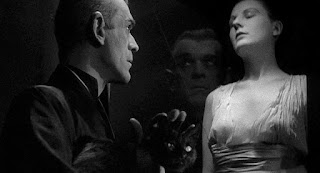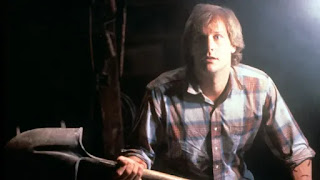by A.J.
Night 13: Happy Happy Halloween
“I’ve rented the house on Haunted Hill tonight so my wife can give a party. A haunted house party… You’re all invited.”
Fright Favorites written by David J. Skal and published by TCM describes House on Haunted Hill (1959) as “one of the most preposterous movies ever made—and one of the most enjoyable.” “Preposterous” and “enjoyable” are the key words to House on Haunted Hill, one of the classic “so bad it’s good” movies. It is also genuinely entertaining and even has a good scare or two. It was produced and directed by William Castle, who was as much a showman as a filmmaker. He would incorporate carnivalesque gimmicks into the theatrical experience and since his movies were typically low budget and cheesy, this only made them more fun. His most famous gimmick was rigging certain theater seats with a buzzer and hiring actors to jump in their seats during a scene when the monster escapes in The Tingler. For House on Haunted Hill the gimmick was presenting the film in “Emergo'' which meant that for a certain scene a model skeleton, seeming to emerge from the screen, would fly over the audience. The effect didn’t always work. Castle was well aware of his audience, mostly younger people and children, and knew how to give them a good time. House on Haunted Hill is still a good time
The plot is a take on the ‘old dark house’ story, a type of whodunnit where people gathered in a creepy house had to solve a mystery or murder. The possibility of the supernatural loomed but the solution was rational. Horror legend Vincent Price stars as Fredrick Loren, the host of the party; he also feels like a master of ceremonies. He has invited 5 strangers to a supposedly haunted house he rented to have a party for his wife and is offering $10,000 to the guests if they make it through the night, or he’ll give it to their nearest relative if they don’t survive. So, the bottom line is he’s giving away money no matter what. He may also be using the party as an elaborate way to kill his wife, Annabelle (Carol Ohmart). They cannot stand each other and she only speaks to him with contempt. In one scene he looms over her, pulls her by her hair, asks, “Would you adore me as much if I were poor?” and gives a sinister chuckle. The haunted house party was her idea but he is the host and their continued bickering over whose party it is makes for an unusual, likely unintentional, running gag.
The protagonists should be Nora, a secretary, and Lance, a test pilot, but she does little more than wander into one spooky situation after the other and scream at everything and Lance proves to be an uncharismatic dolt. Elisha Cook Jr plays the Elisha Cook Jr role, meaning he is the weak pushed around nerd and/or geek. He is the owner of the house and also the most afraid of it. He plays his character well but has little more to do than show up and rattle on about ghosts. Price and his charisma really hold the movie together. You know he is up to no good but want to see where he is going.
Just how ridiculous is this movie? It opens with a montage of screams over a black screen followed by not one, but two floating heads that appear and explain the premise of the movie. The house has a pre-existing pool of acid in the basement, you might call it Chekhov’s pool of acid. One jump scare that legitimately works, even after repeat viewings, has Nora being surprised by the creepy witch-like face of one of the caretakers. This is immediately followed by one of the most hilarious moments on film as the caretaker-witch simply glides away as though she is a mannequin being pulled on a skateboard. The most preposterous moment of the movie has all of the characters agreeing to a good idea: they will stay in their rooms for the rest of the night. Then they all leave their rooms and start wandering again and no one ever brings up that they were supposed to stay in their rooms. In a great reveal, Price emerges from the shadows wearing an elaborate marionette pulley system and he sells it completely.
This movie is not scary but it is so much spooky good fun. I think William Castle would be satisfied to hear that his House on Haunted Hill is still entertaining people in the 21st century, even without an inflatable skeleton flying over them. He also wouldn’t be surprised. House on Haunted Hill is in the public domain so you can easily find it streaming and on DVD in both colorized and original black and white (naturally I recommend the black and white). For some extra fun, you can watch the RiffTrax Live version, currently streaming on Tubi, featuring the former stars of Mystery Science Theater 3000, Mike Nelson, Bill Corbett and Kevin Murphy, providing a hilarious commentary to the movie as well as some shorts.






























